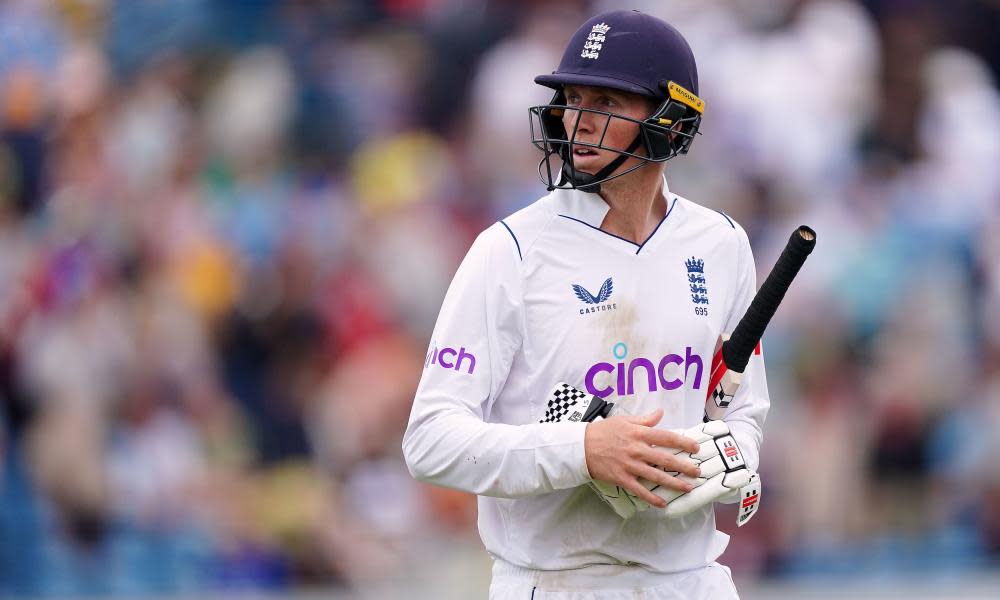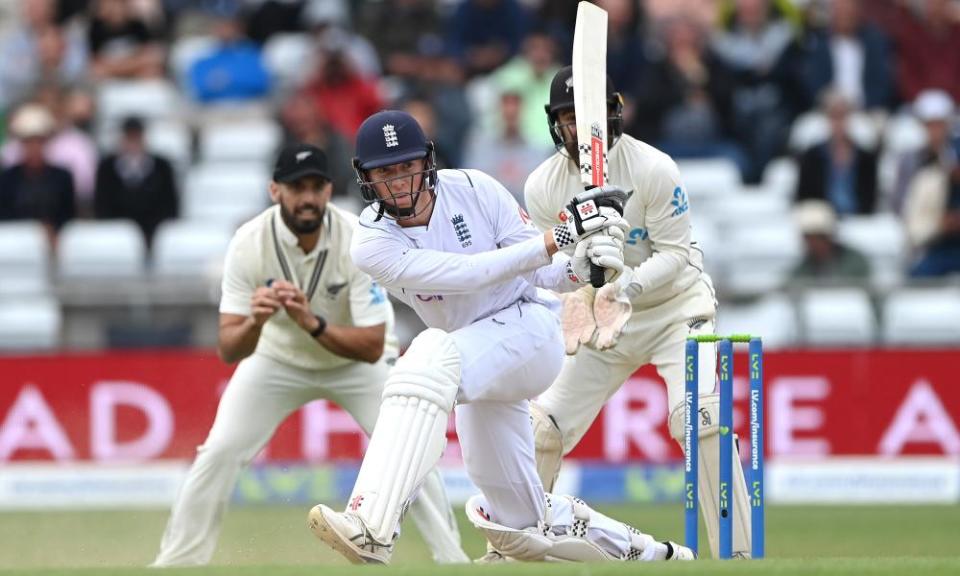Zak Crawley should be a perfect fit for this England but offers only high farce

And frankly, were we not entertained? There were times during Zak Crawley’s blustery, tempestuous second innings at Headingley when you wondered whether we were watching a kind of brilliant performance art, perhaps even a sort of interpretative dance in which a 24-year-old man attempts to express the full gamut of human emotion via edges alone.
Either way you could argue that there is no player in this all-singing England team fulfilling his brief more perfectly than Crawley.
Related: England step up the chase to close on series sweep against New Zealand
Ben Stokes may have the star power. Jonny Bairstow may have the heroism and daring. But even they tend to play only one shot at a time. Crawley has them all and wants to play them all at once: a performer who seems to capture the unique complexity of Test batting while simultaneously persuading us that anybody could do it.
Crawley made 25 off 33 balls on Sunday evening. He scored six fours. Based on those numbers alone you can probably picture his innings without watching a second of it. But even by Crawley’s slapdash standards this was a masterclass in high farce: the innings of a man trying, and failing, and failing harder, and very possibly playing himself out of a Test career in the process.
England play India on Friday in the fifth Test of their delayed 2021 series. Had Crawley simply nicked off for a second-ball duck, his place would probably be safe. But this was the sort of innings that changes minds. He was dropped on 0. He was almost run out. He almost played on twice. He survived three lbw shouts ranging from hopeful to concerted. And of course, he actually did run out his opening partner, the Yorkshire-born Alex Lees playing a Test at Headingley for the first time.

All before he had played a single intentional scoring shot. And so naturally, with the pitch still playing nicely and England in pursuit of another landmark target, you wondered whether this might just be Crawley’s day. You speculated that for all his travails he was taking the shine off the new ball, mainly by slashing it to pieces with the edge of his bat. At which point Crawley took 16 effortless runs off a single Trent Boult over, and for a fleeting few minutes the clouds parted and the wind briefly whispered “Zak”.
This is the other part. The talent. Or at least what we think we mean when we talk about talent, namely the ability to line up a cricket ball and leather it miles. This is the talent Ricky Ponting was talking about during last winter’s Ashes after watching Crawley blaze a spectacular 77 at the Sydney Cricket Ground. “He probably locks himself in for another couple of years of Test cricket on the back of one innings,” Ponting said. “He showed the mettle, he showed the fight, he showed the intent.”
He has been an international cricketer for almost three years and has not the faintest idea how to construct an innings
Ponting is a fine judge of a player, but he clearly hadn’t watched Crawley very much. Almost every Crawley innings begins with mettle and fight and intent. He blazes a few sumptuous boundaries with a schoolboy’s panache.
The long levers, the easy power, the keen eye, the quick hands: all of this fits into the narrow parameters of what we call “talent”. Sometimes he carries on. Sometimes he even makes a score. Once he even got as far as 267. It all looks so natural and satisfying that we forget about his first-class average of 31, we forget about all the times he’s made us dream and then nicked one to slip.
And then he nicks one to slip. Or, as here, he tries to smash Michael Bracewell against the spin, through the covers, and gets caught. And you realise that at this level talent consists of more than hand-eye coordination. Crawley has been an international cricketer for almost three years now and literally has not the faintest idea how to construct an innings, how to modulate his temperament, how to judge which balls to hit, how to bat with a partner, how to play a situation, how to adapt to conditions. This, too, is talent. And in 24 Tests Crawley has delivered precious little evidence of any of it.
Or how to rotate the strike. As a Test opener, Crawley has scored 60% of his runs in boundaries. That’s a lot. Over the same period the corresponding percentage for Rohit Sharma is 55%, Abid Ali 53%, Tom Latham 50%, Dimuth Karunaratne 49%, David Warner 48%. Warner in particular is a brilliant runner of early singles, demonstrating intent and manipulating the field. Crawley, by contrast, wants four or nothing. Perhaps one of the reasons he was so flummoxed when Lees ran down the pitch in search of a quick single was that he hadn’t remotely considered the possibility that one might be on.
There is, perhaps, a certain irony in that the batter perhaps most supremely aligned with the ethos of the Stokes/McCullum regime is the one performing most poorly under it. But in reality England’s new approach is not so much about pure hitting as it is about empowerment: encouraging players out of their shells, shedding their inhibitions. Crawley has no need for any of this. If anything, this is a player who could frankly do with a complex or two. Who needs to fear failure a little more. Who needs to go back to county cricket and do a little growing up.

 Yahoo News
Yahoo News 
